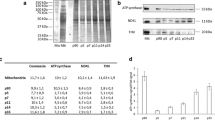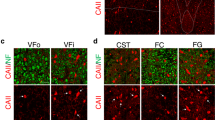Summary
Oligodendroglia in the “Shiverer” spinal cord at 2, 4, 8 and 18 weeks of age were investigated by electron microscopy, with special reference to the process of myelin formation. The predominant changes observed were vacuolization of the cytoplasm during 2 and especially 4 weeks of age, indicating initial steps in the formation of myelin sheaths, although their total volumes was very small and their lamellae were incomplete. Polymorphic vacuoles and vesicles with various electrondense contents appeared to originate from the Golgi complex and the rough-surfaced endoplasmic reticulum (r-ER), since such vacuoles happened to be continuous with the Golgi complex, and the Golgi complex disappeared concomitantly with the appearance of great numbers of vacuoles. The r-ER was also fragmented together with the occurrence of vesicles. After 8 weeks of age, the number of myelinated nerve fibers reached the plateau of the increasing curve, while the number of myelin lamellae successively increased until the sheaths were completed. At these stages the oligodendroglia containig vacuoles gradually disappeared, although numerous oligodendroglia possessing a nucleus with peripheral, densely clumped chromatin were present. These dark oligodendroglia contained a Golgi complex, r-ER with small, single cisternae and microtubules of irregular thickness, different from those found in the control oligodendrogila. At 18 weeks of age polymorphic vacuoles had disappeared in most oligodendroglia.
Similar content being viewed by others
References
Bindle R, March E, Miller JR (1973) Mouse News Lett 48:24
Bunge RP (1968) Glial cells and the central myelin sheath. Physiol Rev 48:197–251
Chernoff G, March E, Miller JR (1974) Mouse News Lett 5:12
Dupouey P, Jacque C, Bourre JM, Cesselin F, Privat A, Baumann N (1979) Immunochemical studies of the basic protein in Shiverer mouse devoid of major dense line of myelin. Neurosci Lett 12:113–118
Inoue Y, Sugihara S, Nakagawa S, Shimai K (1973) The morphological changes of oligodendroglia during the formation of myelin sheaths-Golgi study and electron microscopy. Okajimas Folia Anat Jpn 50:327–344
Inoue Y, Nakamura R, Mikoshiba K, Tsukada Y, (1981) Fine structure of the central myelin sheath in the myelin deficient mutant shiverer mouse, with special reference to the pattern of myelin formation by oligodendroglia. Brain Res 219:85–94
Inoue Y, Nakamura R, Mikoshiba K, Tsukada Y (1982) The formation patterns of central myelin sheaths in the myelin deficient mutant shiverer mouse. Okajimas Folia Anat Jpn 58:613–626
Kruger L, Maxwell DS (1966) Electron microscopy of oligodendrocytes in normal rat cerebrum. Am J Anat 118:411–436
Meier C, Jerschkowitz N, Bishoff A (1974) Morphological and biochemical observations in the Jimpy spinal cord. Acta Neuropathol 27:349–362
Mikoshiba K, Aoki E, Tsukada Y (1980) 2′, 3′-Cyclic nucleotide 3′-phosphohydrolase activity in the central nervous system of a myelin deficient mutant (Shiverer). Brain Res 192:195–204
Millonig G (1962) Further observation on a phosphate buffer for osmium solution in fixation. Proceeding of Vth International Congress for Electron Microscopy, Vol 2:8
Mori S, Leblond CP (1970) Electron microscopic identifaction of three classes of oligodendrocytes and a preliminary study of their proliferative activity in the corpus callosum of young rat. J Comp Neurol 139:1–30
Peters A, Palay S, Webster H deF (1976) The neuroglial cell. In: The fine structure of the nervous system: The neurons and supporting cells. WB Saunders Company, Philadelphia London Toronto
Privat A, Jacque C, Bourre JM, Dupouey P, Baumann N (1979) Absence of the major dense line in myelin of the mutant mouse ‘shiverer’. Neurosci Lett 12:107–112
Rosenbluth J (1980) Central myelin in the mouse mutant shiverer. J Comp Neurol 194:639–648
Sato T (1967) A modified method for lead staining of thin sections. J Electron Microsc 16:193
Sternberger NH, Itoyama Y, Kies MW, Webster H deF (1978) Immunocytochemical method to identify basic protein in myelin-forming oligodendrocytes of newborn rat CNS. J Neurocytol 7:251–263
Watanabe I, Bingle GJ (1972) Dysmyelination in “Quaking” mouse. Electron microscopic study. J Neuropath Exp Neurol 31:352–369
Wisniewsky H, Morell P (1971) Quaking mouse: Ultrastructural evidence for arrest of myelinogenesis. Brain Res 29:63–73
Author information
Authors and Affiliations
Rights and permissions
About this article
Cite this article
Inoue, Y., Inoue, K., Terashima, T. et al. Developmental changes of oligodendroglia in the posterior funiculus of “Shiverer” mutant mouse spinal cord, with special reference to myelin formation. Anat Embryol 168, 159–171 (1983). https://doi.org/10.1007/BF00315814
Accepted:
Issue Date:
DOI: https://doi.org/10.1007/BF00315814




